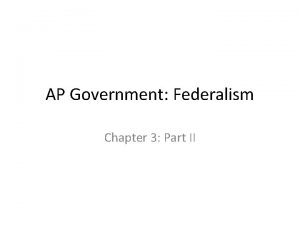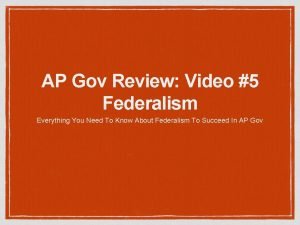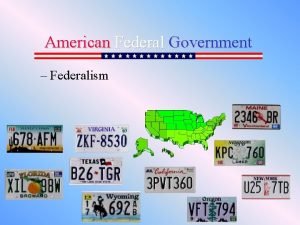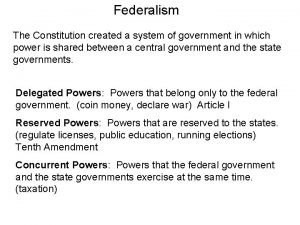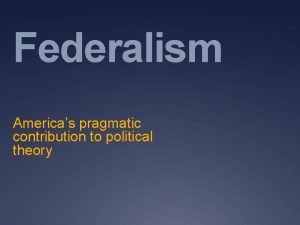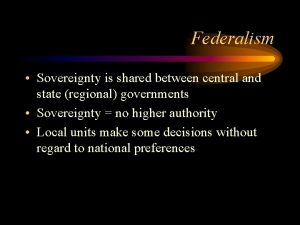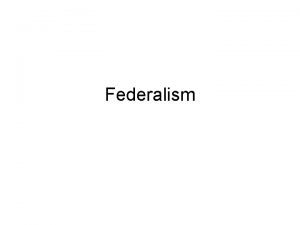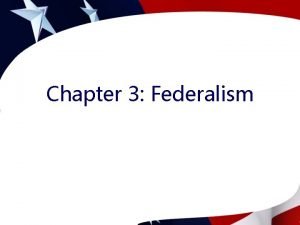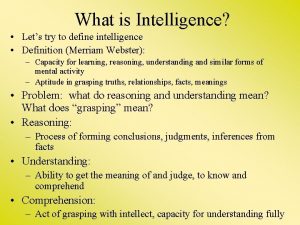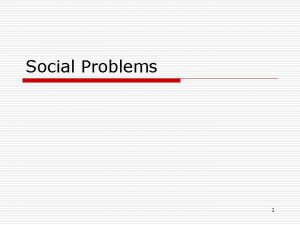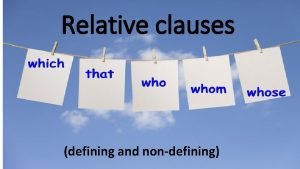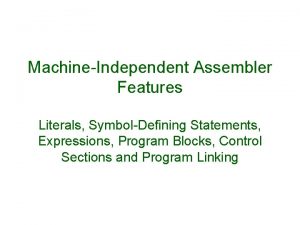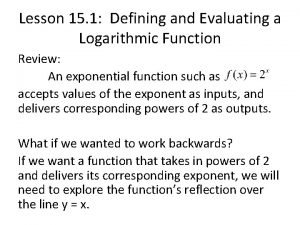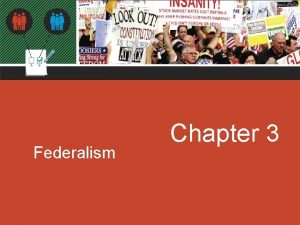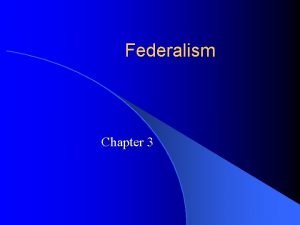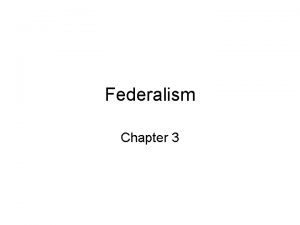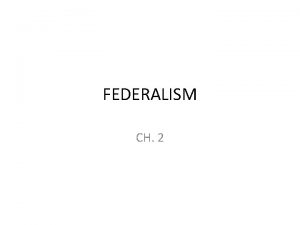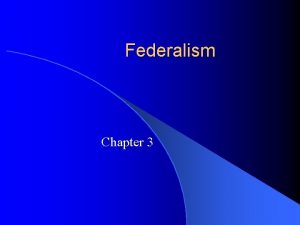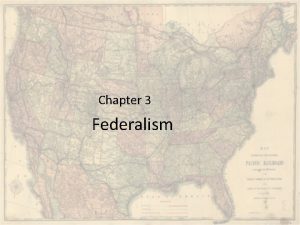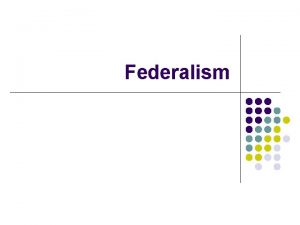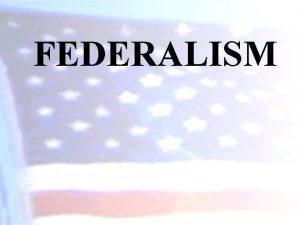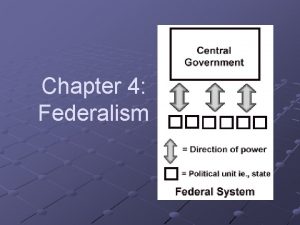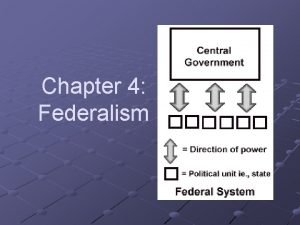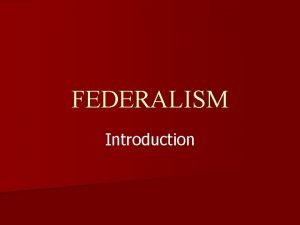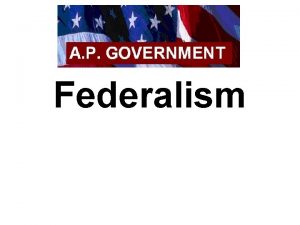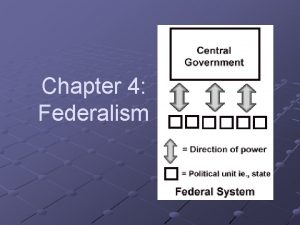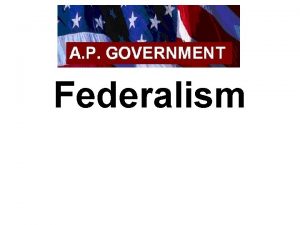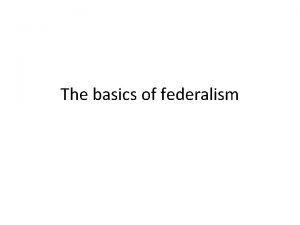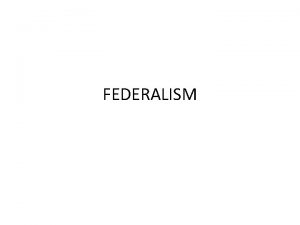Federalism Defining Federalism l What is Federalism Definition



























- Slides: 27

Federalism

Defining Federalism l What is Federalism? – Definition: A way of organizing a nation so that two or more levels of government have formal authority over the land people. – i. e. decentralizing of power/sharing of wealth

Separate Powers “The state and federal governments are in fact but different agents and trustees of the people, constituted with different powers” l -Madison, Federalist #46 l

Defining Federalism l Why is Federalism So Important? – Decentralizes our politics l More opportunities to participate – Decentralizes our policies Which government should take care of which problem? l States can solve the same problem in different ways. l

Delegated Powers • Expressed powers • in the Constitution • Implied powers • reasonable deduction from expressed powers. • Make expressed powers work • Inherent powers • All governments have these • Ex) immigration, foreign policy


l Concurrent - shared power. – i. e. education, taxation l Reserved - states rule – – i. e. welfare, local education control, local gov’ts, professional licensing. Mc. Cullogh v. Maryland. 1819, banking issue set forth the “elastic clause” that gave the Congress the Necessary and Proper powers (implied powers) to enact policies to run the country! 7

Necessary and Proper Clause l “To make all Laws which shall be necessary and proper for carrying into Execution the foregoing Powers and all other Powers vested by this Constitution in the Government of the United States, or in any Department or Officer thereof. ” l —Article I, Section 8, Clause 18 l Led to increased power of the federal government

Federalism Graphic Org A. B. C. D. E. F. G. H. I. J. K. L. M. Establish date, time and place of elections for Congress Operate schools Establish uniform laws of navigation Borrow money Create titles of nobility Regulate interstate commerce Make laws Coin money Tax exports Establish parks Make treaties Establish marriage and divorce laws Levy taxes N. O. P. Q. R. S. T. U. V. W. X. Y. Pass ex-post facto laws Issue business licenses Build roads Declare war Amend the constitution Favor the port of one state over another Establish post offices Appoint someone to fill a Senate vacancy Deny the privilege of habeas corpus except in time of war Establish courts Raise an army Regulate intrastate commerce

Federalism Graphic Org l Use this document to help you fill out the previous options: l Federalism Graphic Organizer

State retain power unless. . . 3. If not stated- states have the rights – Stated? ? ? 10 th Amend! 4. Commerce power - Gibbons v. Ogden. Interstate + international commerce. Congress rules! 11

5. Full Faith and Credit clause - One state’s validity carries over state borders - i. e. marriage licenses. Today’s issue - Homosexual marriages and insurance coverage. The courts may decide. . . 6. Privileges + Immunity clause. . . Citizens of one state will not be discriminated when they visit another. . . sales tax for only tourists>>> nope. . . but what about of state tuition? Or only residents can vote in elections? Court has been unclear. 12

National Govt & 50 States l Feds must do the following: – Guarantee every state has republican form of govt l Sup Ct said President & Congress decide – Protect from foreign invaders – Assist with internal disaster – Respect territorial integrity

Ex: Hurricane Katrina in 2005

Admitting New States l Congress has power to admit – Exception: New state not created from existing states without state legislature consent l How to become a state? – – – – Territory requests Congress passes Enabling Act Convention prepares state constitution Voters in proposed state approve Congress reviews constitution Passes act of Admission President signs

Exceptions l Supreme Court ruled in Coyle v. Smith that Congress can put special rules in place for admission but cannot affect ability of state to manage internal affairs

From Dual to cooperative federalism a. Education sets the stage for both the Feds + states to work together in “fiscal harmony” b. “Shared Costs” of Fiscal federalism. Why use federal help at the “expense” of state sovereignty? (1) Feds had the bucks. . . surpluses abounded (2) Fed income tax in 1920’s (3) Feds could print more if needed more (4) Politics - States saw it as “free”money. Why not pursue it. . . Constituents benefitted! 17

c. Grant-In-Aid programs been around for 200+ years. Feds sell land to fund programs! d. Categorical grants - specific $$ for specific project w/ strings attached. . . nondiscriminatory - Cross cutting requirements Offenders lose it all! (1) Project grants - NSF - competitive requests (2) Formula grant- Do you meet the formula. i. e. public housing, employment programs 18

e. Block grants - social service endeavors w/ less strings attached. SIGS pursue the $350 billion f. Mandates - Feds dictate specific guidelines. . . if don’t comply, penalized or lose the funding. . . Special ed, Disability Act, Clean Air. . . Medicaid (a) unfunded mandates. . . Laws w/o funding. . . (b) Printz vs. US claimed forcing sheriff’s departments to pursue gun permits w/o fed $$$$ was unconstitutional. . . but unfunded mandates still occur today. 19

g. Not all states are treated equally. . . when it comes to fiscal federalism. . . its the role of the politician to take care of ones constituents! With a $3 trillion budget, there is plenty to fight for! h. More and more responsibility is falling upon the states to address funding issues. . . Devolution. 20

i. Devolution 1. Federal gov’t is sending less and less money down to the states. 2. Welfare to Work Reform act of 1996. . . 3. Feds cutting welfare benefits, forcing states to move people off welfare rolls. j. Federalism issues today: a. NCLB b. Border Fence c. Gay Marriage d. Eminent Domain e. Legalizing MJ f. Teri Schaivo. . . g. Patriot Act h. Balance the budget Amendment. i. State militia nationalization. 21

Intergovernmental Relations Today

Intergovernmental Relations Today l Fiscal Federalism – Definition: The pattern of spending, taxing, and providing grants in the federal system; it is the cornerstone of the national government’s relations with state and local governments. Figure 3. 2

Intergovernmental Relations Today l Federal Grants to State and Local Governments (Figure 3. 1)

Understanding Federalism l State Welfare Benefits (Figure 3. 3)

Understanding Federalism l Spending on Public Education (Figure 3. 4)

Understanding Federalism
 Examples of defining and non defining clauses
Examples of defining and non defining clauses Relative clauses defining and non defining
Relative clauses defining and non defining Non defining relative clauses as sentence modifiers
Non defining relative clauses as sentence modifiers Defining relative clause meaning in telugu
Defining relative clause meaning in telugu Defining non defining farkı
Defining non defining farkı Non defining relatives clauses
Non defining relatives clauses Fiscal federalism definition ap gov
Fiscal federalism definition ap gov Dual federalism definition ap gov
Dual federalism definition ap gov What is this
What is this Conflicted federalism definition
Conflicted federalism definition Dual federalism definition ap gov
Dual federalism definition ap gov Picket fence federalism definition
Picket fence federalism definition Pragmatic federalism definition
Pragmatic federalism definition Creative federalism definition
Creative federalism definition Dual federalism definition
Dual federalism definition Picket fence federalism definition
Picket fence federalism definition Definitions of intelligence
Definitions of intelligence The defining moment in greek history is the wars.
The defining moment in greek history is the wars. 4 defining characteristics of chordates
4 defining characteristics of chordates Sociological perspectives on social problems
Sociological perspectives on social problems Lord capulet defining quotes
Lord capulet defining quotes Lady montague defining quotes
Lady montague defining quotes Nondefining relative clause
Nondefining relative clause Situational poverty definition
Situational poverty definition Program block and control section
Program block and control section Lesson 15.1 defining and evaluating a logarithmic function
Lesson 15.1 defining and evaluating a logarithmic function Definition of leadership
Definition of leadership What is the research problem
What is the research problem






